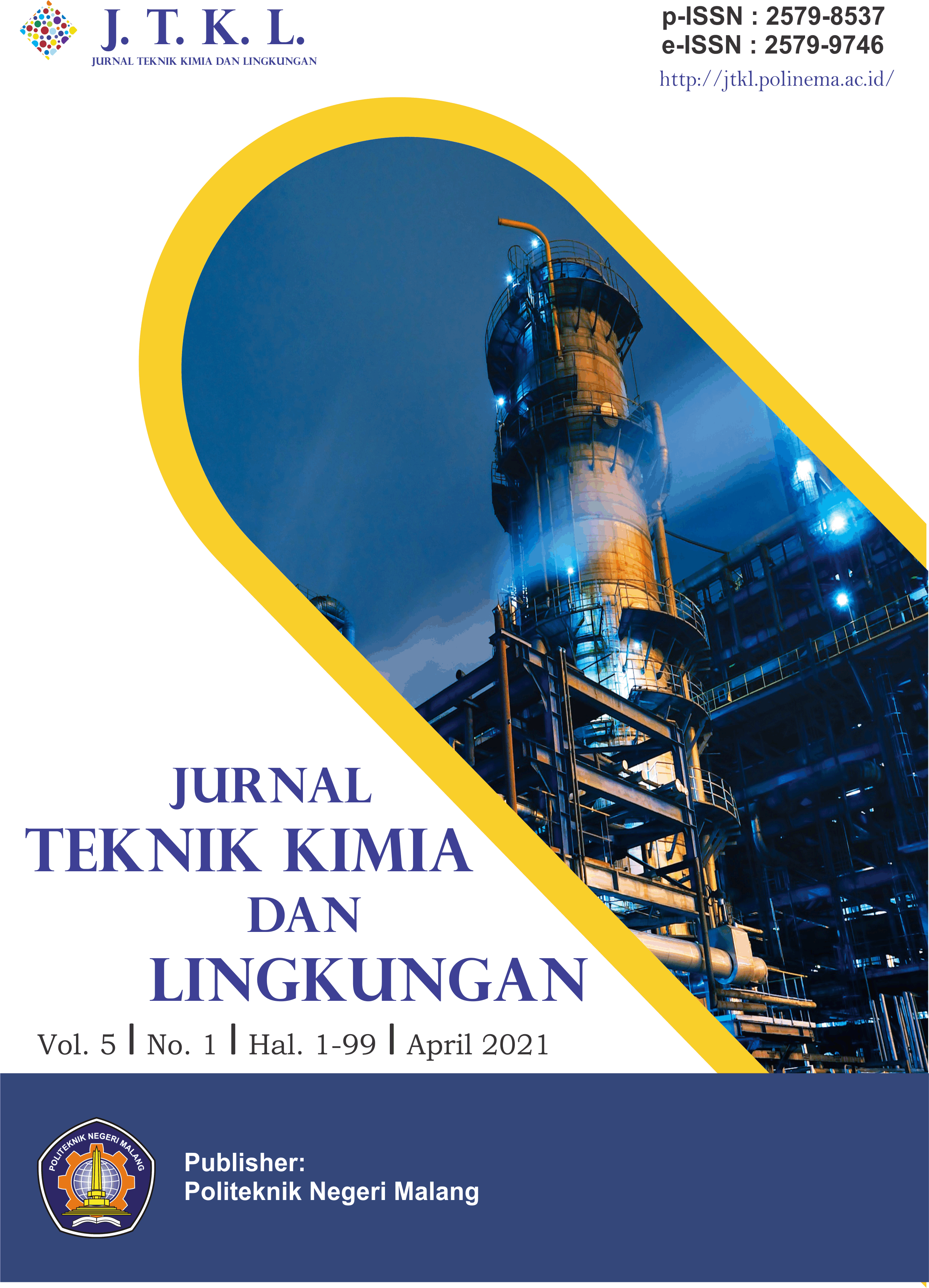Penggunaan Tanah Vertisol Sebagai Bahan Baku Pembuatan Silika
DOI:
https://doi.org/10.33795/jtkl.v5i1.212Keywords:
extraction of alkali, silica, vertisol soil, XRF.Abstract
Silica is widely used in industry. The aim of this study was to determine the silica content in vertisol soil in Bringinbendo village. This research was started by soaking the soil in aquadest, then washed 3 times and dried it at 110 ° C for 24 hours. Furthermore, smoothed to 250 mesh size. The second stage is the synthesis of silica using the alkaline extraction method and the treatment of acids. 20 grams of soil powder were extracted in 100 ml NaOH (3, 5, dan 7M) while stirring and heated at 80 ° C. Next, 250 ml of aquadest was added and filtered using Whatman paper. The filtrate was titrated with 5M HCl while stirring until the pH reached 7. The suspension was maintained at room temperature for 24 hours, filtered, and 5 times with aquadest then dried. The results of the mass study were that the greatest silica was found in 7M NaOH concentration at 1 hour, namely 2.59 grams and vertisol soil in Bringinbendo Village had silica content in the medium category with a proportion of 77.7%.
References
Alimin, Maryono, S. E. Putri, Analisis Kandungan Mineral Pasir Pantai Losari Kota Makassar menggunakan XRF dan XRD, Jurnal Chemica, vol. 17, no. 2, hal. 19-23, 2016
L. Silvia, M. Zainuri, Analisis Silika (SiO2) Hasil Kopresipitasi Berbasis Bahan Alam menggunakan Uji XRF dan XRD, Jurnal Fisika dan Aplikasinya, vol. 16, no. 1, hal. 12-17, 2020.
W. A. Adi, R. Fauzy, Y. Taryana, Yusmaniar, Pengaruh Komposisi Silika dari Abu Sekam Padi terhadap Daya Serap Gelombang Elektromagnetik pada Komposit Unsaturated Polyester Resins/Silika, Jurnal Ilmu Dasar, vol.19, no. 1, hal. 7-16, 2018.
Aminullah, E. Rohaeti, Irzaman, Reduction of High Purity Silicon from Bamboo Leaf as Basic Material in Deevelopment of Sensors Manufacture in Satellite Technology, in Abbrev. Procedia Environmental Sciences, 2015, hal. 308-316.
A. F. ’Adziimaa, D. D. Risanti, L. J. Mawarni, Sintesis Natrium Silikat dari Lumpur Lapindo sebagai Inhibitor Korosi, Jurnal Teknik Pomits, vol. 2, no. 2, hal. 384-388, 2013.
L. P. Singh, S. K. Agarwal, S.K. Bhattacharyya, U. Sharma, S. Ahalawat, Preparation of Silica Nanoparticles and Its Beneficial Role in Cementitious Materials, Nanomaterials and Nanotechnology, vol. 1, no. 1, hal. 44-51, 2011.
Anon, Soluble Silicates and Their Applications. Crossfield Publication, Crossfield, Warrington, UK, 1997.
C. J. Brinker, G. W. Scherer, Applications. In: Sol-Gel Science, The Physics and Chemistry of Sol-Gel Processing. Academic Press, San Diego, 1990.
A. Rahman, Pembuatan Nanosilika Gel Dari Silika Abu Sekam Padi, Jurnal Fisika dan Terapannya, vol. 5, no. 1, hal. 12-28, 2018.
P. A. Handayani, E. Nurjanah, W. D. P. Rengga, Pemanfaatan Limbah Sekam Padi Menjadi Silika Gel. Jurnal Bahan Alam Terbarukan, vol. 4, no. 2, hal. 55-59, 2015.
N. Listiyani, A. P. Dharmawan, F. Afifah, S. E. Cahyaningrum, Pemanfaatan Lumpur Lapindo sebagai Bahan Baku Pembatan Amplas, Indonesian Chemistry and Application Journal (ICAJ), vol. 3, no. 1, hal. 24-27, 2019.
L. Silvia, M. Zainuri, Suasmoro, B. A. Subagyo, H. Sukamto, Mashuri, S. Y. Purwaningsih, Analisis Kandungan Mineral Pasir Pantai di Kabupaten Pacitan dengan Metode Ekstraksi, in Abbrev. Prosiding, Seminar Nasional Edusaintek, Semarang: FMIPA UNIMUS, 2018, hal. 16-20.
R. B. Cate, L. A. Nelson, A Rapid Method for Correlation of Soil Test Analyses with Plant Response Data, North Carolina: Technology Bulletin, 1965.
Jamaluddin, E. P. Umar, Identifikasi Kandungan Unsur Logam Batuan Menggunakan Metode XRF (X-Ray Flourescence) (Studi Kasus: Kabupaten Buton), Jurnal Geocelebes, vol. 2, no. 2, hal. 47-52, 2016.
W. P. Sari, D. Sumantri, D. N. A. Imam, S. Sunarintyas, Pemeriksaan Komposisi Glass Fiber Komersial dengan Teknik X-Ray Fluorescence Spectrometer (XRF), Jurnal B-Dent, vol. 1, no. 2, hal. 156-162, 2014.
N. Jafar, Analisis Unsur Endapan Bauksit menggunakan X-Ray Fluorescence (XRF) PT. Antam Tbk. Unit Geomin Daerah Kenco Kabupaten Landak Provinsi Kalimantan Barat, Journal of Chemical Process Engineering, vol. 2, no. 1, hal. 45-48, 2017.
Munasir, Triwikantoro, M. Zainuri, Darminto, Uji XRD dan XRF pada Bahan Meneral (Batuan dan Pasir) sebagai Sumber Material Cerdas (CaCO3 dan SiO2), Jurnal Penelitian Fisika dan Aplikasinya (JPFA), vol. 2, no. 1, hal. 20-29, 2012.
A. Setiabudi, R. Hardian, A. Mudzakir, Karakterisasi Material; Prinsip dan Aplikasinya dalam Penelitian Kimia, Bandung: UPI Press, 2012.
Munasir, Triwikantoro, M. Zainuri, Darminto, Ekstraksi dan Sintesis Nanosilika Berbasis Pasir Bancar dengan Metode Basah, Jurnal Penelitian Fisika dan Aplikasinya (JPFA), vol. 3, no. 2, hal. 12-17, 2013.
Aman, P. S.Utama, Pengaruh Suhu dan Waktu pada Ekstraksi Silika dari Abu Terbang (Fly Ash) Batubara, in Abbrev. Prosiding SNTK TOPI 2013, Pekanbaru, 2013.
E. W. Winata, Yunianta, Ekstraksi Antosianin Buah Murbei (Morus alba L.) Metode Ultrasonic Batch (Kajian Waktu dan Rasio Bahan:Pelarut), Jurnal Pangan dan Agroindustri, vol. 3, no. 2, hal. 773-783, 2015.
Downloads
Published
Issue
Section
License
Copyright (c) 2023 Medya Ayunda Fitri, Farikha Alfi Syahriyah, Yulia Tri Rahkadima

This work is licensed under a Creative Commons Attribution-NonCommercial 4.0 International License.







